Vol. 2, Issue 57 - May / June 2015
Posted: Friday 15th May 2015
I have written in the past about the endless rivalry between ‘The Union’ and ‘The League’ so I was interested in the following email from Norman Saxby:-
I enjoy your Cambridge Lightweight News, good reading. In the Issue no. 55 item you write about NCU/BLRC rivalries. My club, Kenton RC, rode in both disciplines. On club nights the roadies would be in one corner and the time trial boys in another but on all club runs we would all be out together, with plenty of banter. I feel sorry for all those clubs who split and went separate ways. Many now do not exist. We are still struggling on!
Norman carries on: Your comments about GB brakes were interesting. I am riding an HE Ferris at the moment. The GB Coureur brakes were hopeless at stopping. The levers were useless. I cleaned and polished the calipers and fitted a pair of Mafac hooded brakes instead. Much better and still look ‘oldish’. Back in my early days I always rode with Mafac centre-pulls and Weinmann levers which were very effective when stopping. They were years ahead of their time and I think almost as good as the dual pivot brakes of today. Mafac centre-pulls look good on most 50’s-60’s bikes and they stop you!!! Keep the wheels turning , Norman Saxby Kenton RC, V-CC, 40 Plus CC.
Ed. I was lunching with some V-CC members (Leaguers who were friends with Percy Stallard in their racing days) on a recent Cambridge ride and we were talking about this subject. I was amazed to hear that someone went into a well-known Bristol bike shop not that long ago and mentioned to the owner that he was in The League back in the time. The shop owner told him to get out of the shop as he didn’t serve Leaguers! How amazing that this still goes on.
Norman mentions above ‘mix-and-match’ with brake levers and callipers. This was a very common practice in the post-war era in the UK and opinions as to the best combination were many. It could happen that a chosen combination would be rife in one club where a few miles down the road another club may reverse the choice. Fashion went down to the smallest detail.
An Appreciation of Bill Harvell by Roger Watts
I first met Bill Harvell when I was thirteen in 1944, a schoolboy newly returned from wartime evacuation to a war-ravaged Portsmouth. My brothers were keen cyclists and suggested that I should visit his small but colourful cycle shop at Hilsea. I soon learned of Bill’s outstanding career as a British cyclist. He had represented our country at the 1932 Olympic Games in Los Angeles and in the Empire Games at Manchester in 1934, winning bronze medals at each. Despite the considerable gap in our ages we became friends and throughout my life I have treasured that friendship and held him in high esteem.
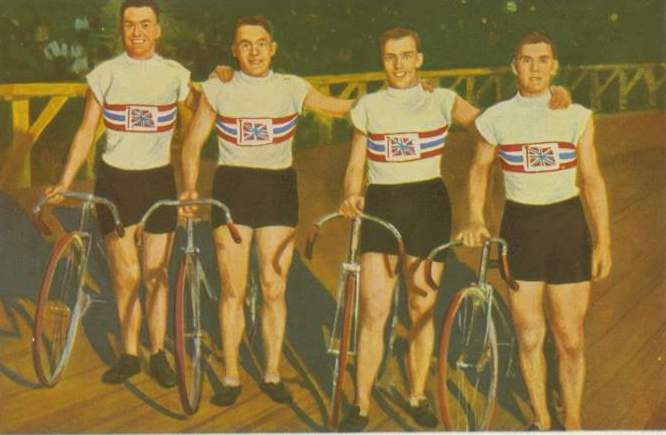
Bill’s obituary in the cycling press said that “He encouraged countless youngsters who came into the sport after the war”. I was lucky to be one of them. He was a warm, interesting and welcoming man who greatly added to my appreciation of life. The son of poor Dorset parents, Bill’s early years had been a constant financial struggle. Despite the challenge he quickly reached the top in British cycling but he remained modest and unpretentious.
In the 1930s Bill time trialled and raced with Freddie Prince, who went on to found Rotrax Cycles in 1945. Bill had shops in Poole and Southampton and he would cycle between the shops, which later became part of the Rotrax business.
Bill’s shop at Hilsea was a Mecca for southern cyclists and was often full of enthusiasts listening to his well-told tales. I got to know all of these stories and from afar could tell from his gestures which epic he was describing. Perhaps the best was about an Isle of Man race which he managed to finish on a bike seriously wrecked by collision with the sandbags at Craig na Baa. His audience sometimes included sailors from the Free French Navy at Portsmouth. Bill spoke no French and used me as a translator in my schoolboy French. What a challenge!
Several of us lads worked for Bill in the late 1940s on Saturdays and during school holidays. He paid no wages but allowed generous access to his dump of smashed bikes and equipment. He was a good wheel builder and competent mechanic. In those days there was a huge shortage of cycling gear. What was available was mostly pre-war, second-hand and beyond our means. With the aid of 1930s French catalogues some of us constructed workable Simplex gears from bits and pieces. We also salvaged chainsets with odd cranks, handlebar stems and seat pillars. I found a pair of Jack Sibbit track bars which even then looked very obsolete!
When we started racing at the age of 14 there were plenty of events at Southampton, Gosport and Portsmouth tracks. There were time trials at various distances on local courses and an occasional massed start race on what became the Goodwood motor circuit. In winter there were indoor roller competitions and even a race between runners and cyclists over a tough cross-country course on Portsdown Hill. Bill was usually at track events and sometimes provided us with an old tandem which helped to liven the pace in training sessions at Alexandra Park.
Few of us could afford track bikes so we rode on stripped-down road machines. On one occasion officials refused to let me take part because removal of my derailleur had left about an inch of spindle protruding beyond the track nut. Bill came to the rescue with a hacksaw and offered to tidy up the projection. This pacified the officials but left me protesting at the cost of a new spindle. Smiling through gritted teeth Bill urged me to stop whining and to get on with the race but he finally offered to pay for a new item.
After the 1948 Olympics Portsmouth staged a major track meeting which attracted an international field. Bill was concerned that I had not entered. Fees, though modest, were a problem but he persuaded me to complete the forms and undertook to send them on to the promoters. I shall never know if he exerted any influence but I was astonished to find myself in the same heat of the Half Mile Handicap as Reg Harris, then reigning world sprint champion.
Bill had a keen sense of humour and a wealth of earthy sayings. I think he nursed a bit of a grievance against the 1920s Dorset squirearchy and he often mocked people he regarded as chinless upper-class twits. He had a hilarious story about young naval officers complaining at wartime sugar rationing. We cultivated posh-speak accents to re-enact this saga.
National Service in 1949 took me away from Portsmouth and afterwards my Civil Service job moved me to various parts of the UK. Marriage and rearing a family ended any dreams of racing but in the 1960s we returned to Portsmouth on a brief visit. The Hilsea shop was still there but looked empty. From a back room came the unmistakable sound of wheel building. I raised my voice and called out “Is there no bloody shugah in this shop?” The noise stopped and an ageing Bill Harvell ran into the shop crying “Roger! It’s got to be Roger!” An animated session of nostalgia ensued but it was the last time I saw my old friend.
Years later my brother informed me that Bill had died in his sleep, a great way for such a wonderful guy to go. Over our years of friendship Bill had talked of the many people he knew, including Toni Merkens, the German track champion of handlebar stem fame, who had died on the Russian Front.
I believe that at one stage they had been Madison partners. I like to think there is a great velodrome in the sky where people like Toni, Shake Earnshaw, Claud Butler and Charlie Holland all meet up to re-live their memories. No doubt Bill is there with them, waving his arms about, and recounting the Craig na Baa adventure.
Roger S Watts
Another track rider of this era was Dennis Horn who had a thinly-disguised frame named after him in the pre-war (1938) Claud Butler catalogue:
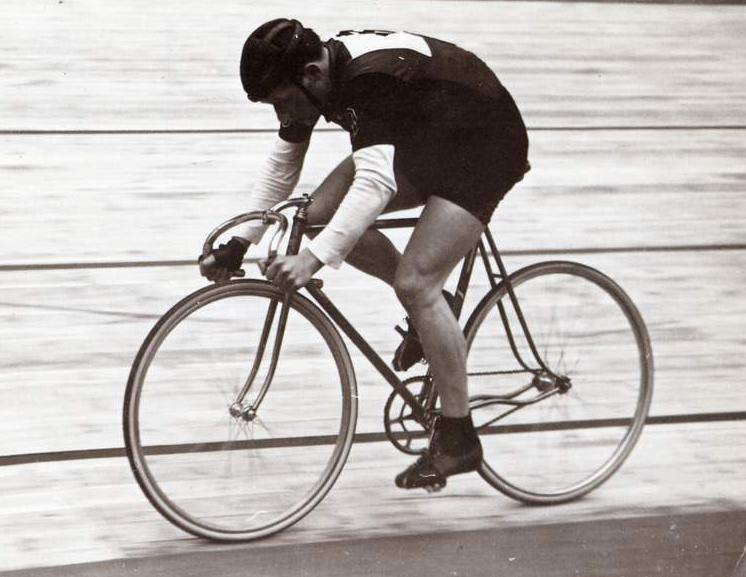
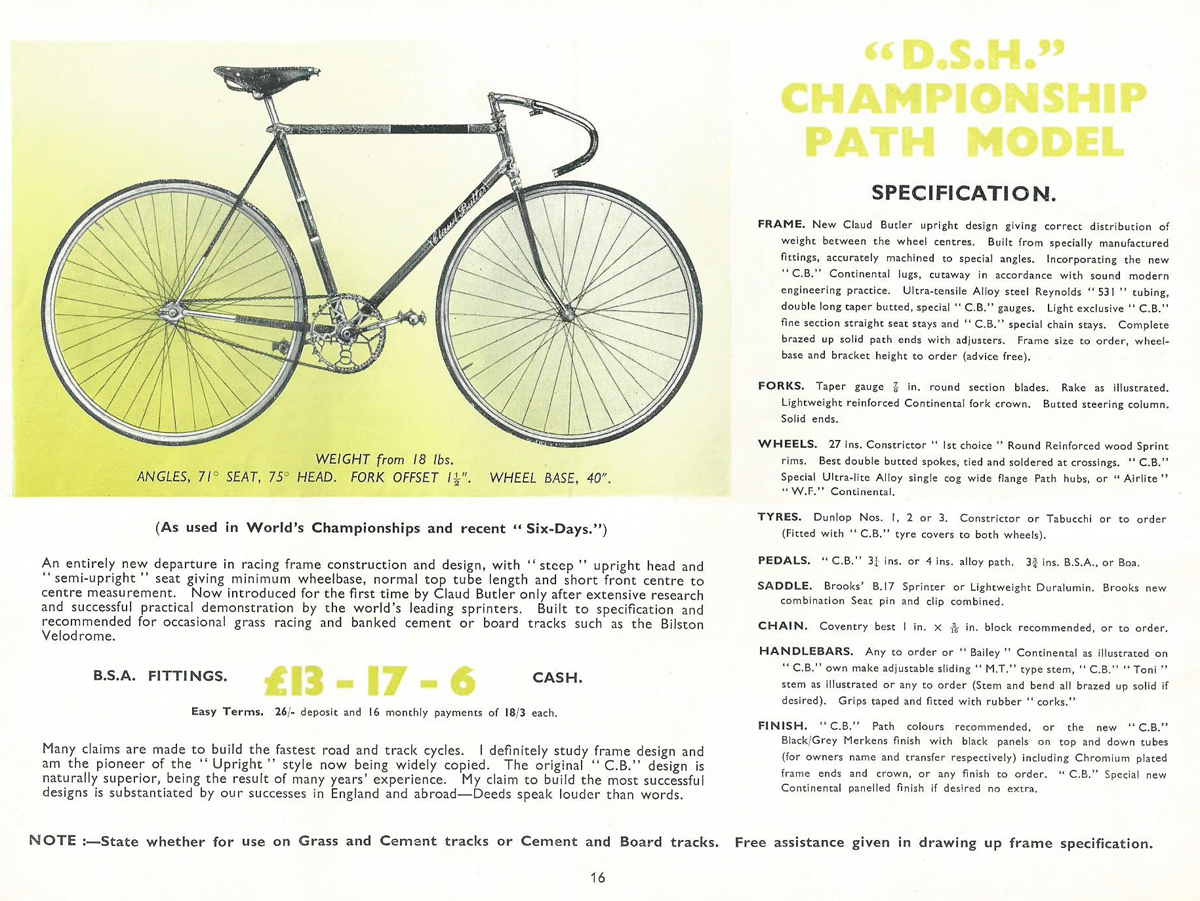
The most common mistake we get from copy submissions is misspelling of the Claud Butler name by the addition of an ‘e’ to the name Claude. This is even done by people who own one of the make but obviously never take in the name on the down tube.
Woman Roller Racing!
We often get emails from the families of builders featured in Classic Builders on the website, often the result of grandchildren ‘Googling’ their family name. Slightly different but just as interesting was the following from Graham Simmons:
Looking through a Classic Builders page about Tom Maysh, I found amongst the pictures of 77 Bowes Road the one headed ‘Woman roller racing 1938’ (detail image below) and I would like to give you the name of that lady as she was my mother and a friend of the Maysh family, I still keep in touch with Odette and Barry.
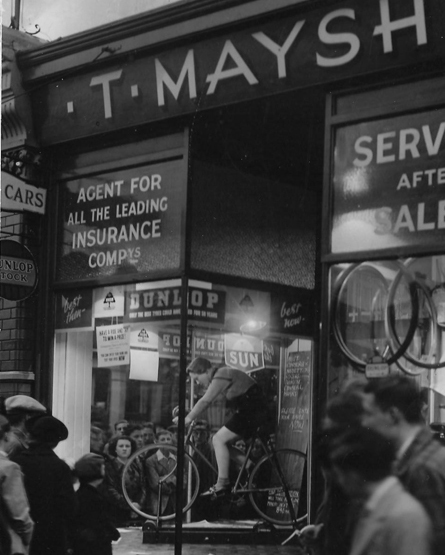
My mother was Doris Simmons (née Abbey) who married my father, Les Simmons, in 1937 until they both died at the end of 2001. Dad was also a member of the Kingsdale Cycling Club and when Mum and Dad married, at the Bowes Road Methodist Church (now Trinity at Bowes) they went on a tandem to North Devon for their honeymoon.
I myself saved and bought one of Tom Maysh cycles in the early 1950’s, it was a black one with Tom Maysh, in white writing, which was one left over from an export order for Canada and after that one was written off in an accident it was replaced by a red one that somehow was lost after moving.
It was interesting looking into the pages and brought back many happy memories.
Prizes in the post-war era
I have mentioned before the great variety of prizes that were awarded at cycling events in Austerity Britain following WWII. One of the jobs undertaken by organisers was to trek around all the shops in the locality begging for prizes , especially for track racing events where there were many races held on the one day with prizes needed for each final. In a small community just about every organisation holding sports events or fund raising with raffles, bingo, etc would be calling at shops begging for donations. Some of the smaller village shops would probably have more ‘beggars’ than customers! Organisers of the bigger events may well have had a prize budget plus a pool of cups, shields, etc to be awarded on the day. Below is a picture that John Cooke, a David rider back in 1948 sent to George Hill recently of George, with a nice haul of trophies, astride his Selbach,.
Some shopkeepers were quite fed up with the constant requests for donations and would scour their shop for something which had sat on the shelves unsold for years. Others with better businesses realised the publicity value of donating something worthwhile. I have heard tell of riders who travelled for miles to compete in quite a prestigious track event and raced in heats, semi-finals and the final of a sprint or pursuit event to be presented with a pair of mudguards for their efforts. Often these were shop-soiled or twisted. The luckier competitors could win something really useful like tubs (tubular tyres or sew-ups)which were probably the most popular prizes .
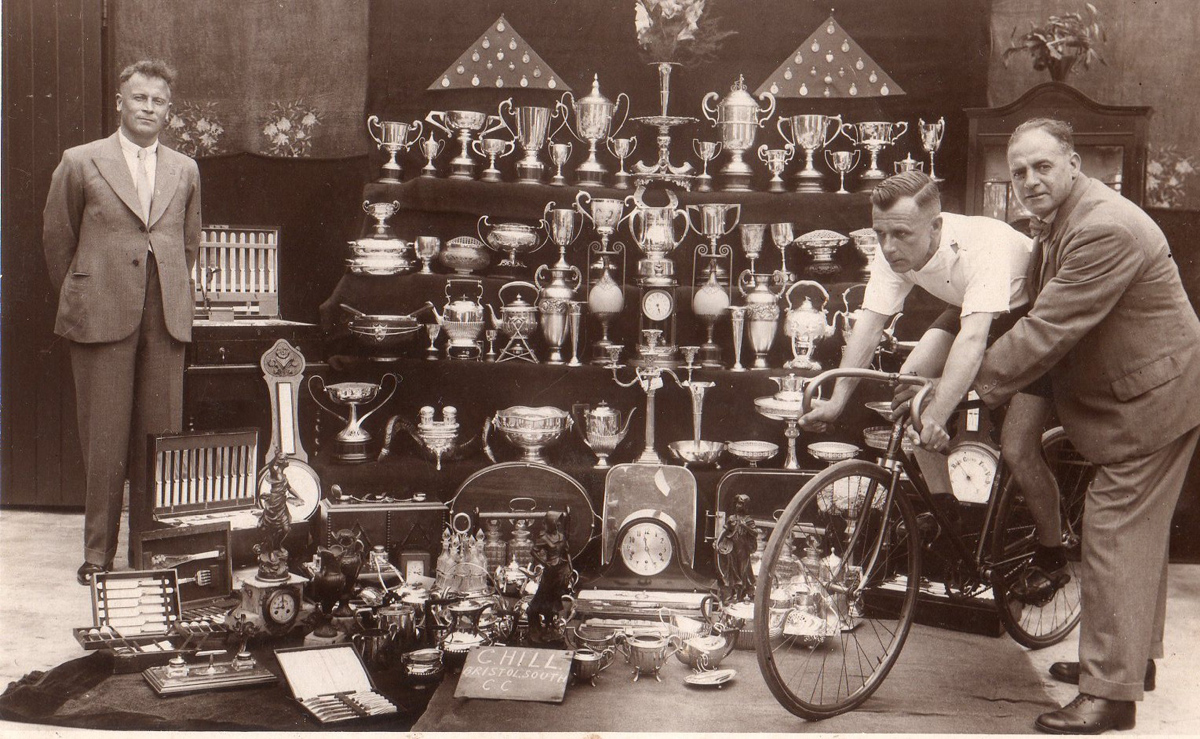
The more staid world of time trialling usually awarded a voucher for the local cycle shop which had to be redeemed on bike parts (or so they hoped).
This same phenomenon took place in the road races organised by the League and a certain lower category of race was known as a ‘Chipper’ where a prize could be a voucher from the local chippie for a bag of fish and chips with a good sprinkling of salt and vinegar thrown in.
Bike shop/cafes
This last twelve months has seen a blossoming of bike shop/cafes opening here in the East of England. The first of this era, now some twelve months old, was Maglia Rosso situated in Hawstead just South of Bury St Edmunds, some thirty miles from Cambridge and is set up in a converted public house with ample grounds. The business consists of a well-equipped independent cycle shop alongside a cafe catering for cyclists. In the grounds there is a sensible cycle parking area plus car parking for the less energetic amongst us.
In February this year Cambridge got it first cycle cafe-shop, Espresso Library, which is situated in a new complex, being part of the fire station re-development on East Road. Many of the staff are keen young cyclists – the ‘patron’ is a successful time triallist – and there is a regular Saturday morning ride for the in-house team and customers, if you can take the pace. The main part of the shop is the cafe, which is larger than most of its type, and the quality of the coffee and food is so high is that it has become an instant focal point for locals who are not cyclists. It all helps to keep a business viable. The floor space is ‘L’ shaped and the walls on one arm have Cycloc wall mounted bike hangers for safe storage of your bike while eating or drinking. The end wall of this arm (and also the other end wall) have drop down screens for projecting classic races from around Europe via Eurosport.
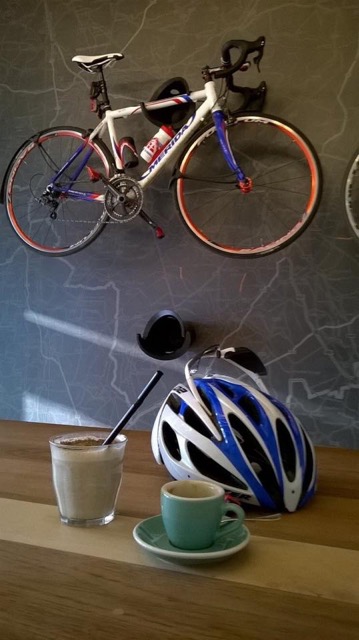
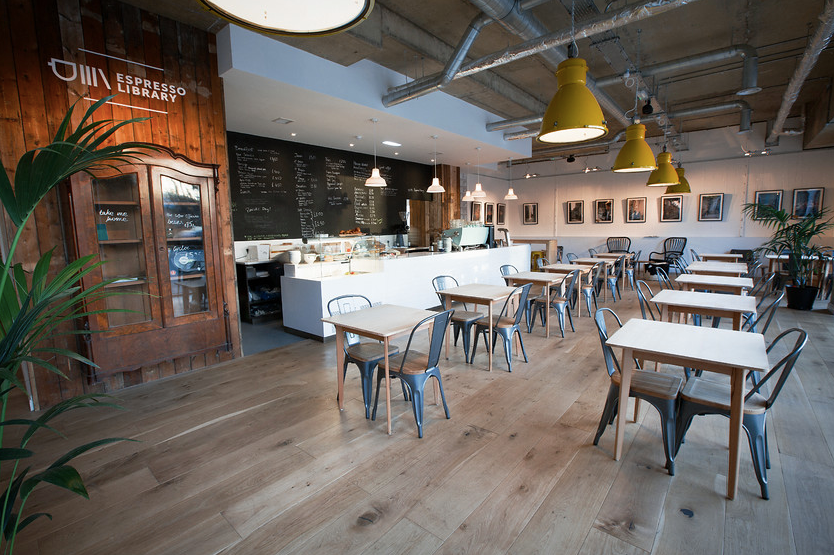
From my own point of view Espresso Library is too close for use as a stop on rides as I can walk there in a few minutes (and often do!). The flip side to this is that I can use it as a meeting point with friends or just for lunch or snacks when not riding. Both the hand-roasted coffee and food are great, especially the post-ride brunches, but at the moment they don’t sell much cycling equipment yet apart from their own cycling kit – which is very smart. This is a business with great emphasis on quality ingredients for both food and coffee and one is always assured of a friendly welcome, especially with a bike.
Some fifteen miles down the road yet another cyclists’ cafe opened on Good Friday at Saffron Walden in Essex. Known as Bicicletta Coffee con Velo they also specialise in high-grade coffee and food as well as stocking both Colnago and Merkx machines and are real aficionados of Italian bikes, which gets bonus house points from me. To complement this they also have a range of good quality cycle clothing.
A few years ago a cafe/delicatessen, The Blue Egg opened at Great Bardfield in Essex. Again, it is the place to go for really good food and drinks. When planning this project, I doubt the owners took into account that it would soon become a favourite among cyclists. However, it has become a magnet for clubs from the South, East and North of Bardfield, no doubt helped by the fact that it is a regular stopping point for Mark Cavendish and Alec Dowsett on training rides, both top level professional riders on the international road race scene. Following their stage wins in the major tours, including the Tour de France and Giro d’Italia, their signed jerseys are displayed on the walls. Often when we visit we find that some fifteen to twenty club members are enjoying a coffee in the pleasant grounds at the rear.
Several other cafes in this area are popular with cycle groups – La Hogue Farm Shop near Newmarket and Abuntu Fairtrade Cafe and Shop at Bourn are two I regularly use.
A fellow cyclist friend of mine explained that before he met me he navigated by and discussed pubs all the time, whereas now all we talk about are tea shops and cafes!
24″ Bates Vegrandis, 1952 frame and forks (not complete bike, but this option negotiable), as listed in Readers’ Bikes on the Classic Lightweights website.
https://www.classiclightweights.co.uk/BatesVegrandis1951.html
Headset included but not bottom bracket. Selling to make room for a Gillott Fleur de Lis acquired from the estate of a friend who recently died. Although the Bates is shown as a fixed wheel machine in Readers’ Bikes the frame is built for gears with forward dropouts plus a cable stop on the chainstay, cable guide on the bottom bracket and a ‘pip’ on the down tube, presumably designed to stop lever slipping when under tension. Very good condition and would not need re-spray- £375
Also:
Pair of ‘Youngs Miche 20’ 650 wheels with Shimano freehub. 24 spoke rear, 20 spoke front. Fitted Vittoria Rubino Pro tyres. 300 miles use only so in as-new condition. £65
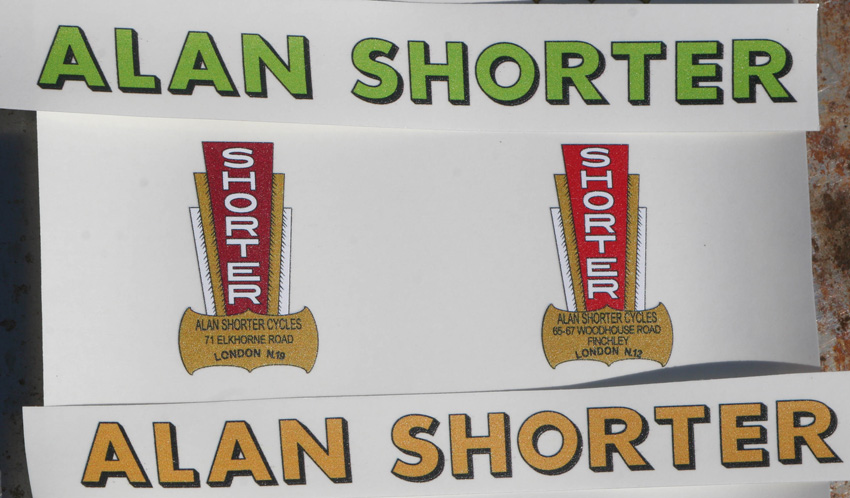
I also have a 3TTT stem with genuine ‘Colnago’ pantograph which is 115mm (3TTT seem to have stems in 5mm increments unless they are 10mm increments on the 5 base). I would like to swap with one of 95 or 100mm as I am rather stretched out on my Colnago Master.
For Sale — CLAUD BUTLER welded (1949)
21 ½” centre to top. Re-sprayed with correct transfers. Known history from around 1959.
Full details in Classic Lightweights – Readers Bikes. £260
Barry Adams
I had the Alan Shorter decals (images below) drawn a while back and they have now been printed., I had some extra ones done with both addresses for the head/seat tube badges, and for the down tube the large block lettering ‘Alan
Shorter’ in gold with black outline and a pale green with black outline.
The head tube badge is on white vinyl and will need cutting out with a scalpel and straight edge. The block lettering is on clear, both will need a varnish/lacquer covering coat after application.
I will have some to spare once I have my frame re-sprayed I am on the trail of another Alan Shorter though ) so it seems a good idea to ask (subject to photographs of the frame and number before renovation ) if anybody else needs some.
Posted: Friday 15th May 2015
This article appears in the following categories.
Upcoming Events
Whether you are looking for a gentle social meet up, or a 100-mile ride browse the community’s upcoming events and plan your next weekend outing.
